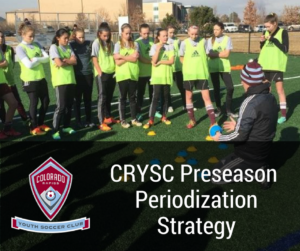Our Preseason Periodization Strategy
Posted by: Andrew Kewley | Director of Coaching
Preseason programming is an incredibly important piece of the Rapids Youth Soccer seasonal plan. Each team or player within the club may have different objectives when it comes to preseason goals due to player age, ability, commitment level, and varied scheduling across the Competitive program. Our Directors of Coaching work hard to ensure that we continue to evolve and tailor our curriculum to meet the needs of the player first, and then the team. By focusing on Long Term Individual Player Development, the work of the collective team becomes much easier.
For the team, it is important to find the right balance of training sessions and games in this preseason period. In order to appropriately plan our programming, Rapids Youth Soccer uses a periodization program that focuses on the macrocycle, microcycle, and mesocycle of our teams and players.

When designing the program’s periodization calendar, Rapids Youth Soccer focuses on player age, ability, and commitment level to maximize the development of each athlete. One athlete training more than another athlete does not correlate to greater development. Especially if an athlete is a multi-sport athlete, pushing an extra session in the work week could hurt the player’s development. Physical and mental overuse can be serious and cause physical injury or burnout. In addition, the quality of the session and movement is key to development. These intricacies are important to consider any time you structure a training program’s macrocycle, microcycle, and mesocycle.
A macrocycle is a year-long view of the team or player’s body of work. When creating a macrocycle, a director is able to manage the preseason, in season, postseason (a period of training after the season with no games) and off season (no games or training sessions). As a club, we are working toward building programs that allow consistency to better match the needs of our players with a robust and well-planned training and game schedule. Directors may also look to add supplemental training and programming for players to fully meet their needs or desires.
The microcycle is a picture of the work a team or player will do in a short period of time. The microcycle is typically one week in duration and is the smallest functional unit of training in a periodization program. The amount of work will vary by the player’s age, team, program and period of the year. Again, age and competition weeks may affect the actual schedule but not the structure of the block of work. It is easy to change a microcycle as it is a small unit and can be more accurately tailored to the needs of a team or player.
Finally, the mesocycle is a body of work that is a month in duration. In using this view, our directors can plan an athlete’s training and game ratios by reviewing performance values. Because the mesocycle is a larger body of work, coaches and directors can plan the intensity and physical/mental workloads of the sessions. If a team has a tournament where they play 4 or 5 games in a very short window of time, the microcycle structure can be temporarily changed to manage the workloads. The work week (microcycle) may also be altered to fit into the mesocycle. For example, if a team normally trains on Tuesday but they just had an event, the director or coach may alter the Tuesday session to be less intense. Rapids Youth Soccer sessions can be tailored to ensure the actions that are performed are recovery actions versus the actions that may take place in a normal training session.
Our program development is designed to maximize the athlete’s learning and performance potential. It is important to understand how our strategy fits into the greater player development pathway and philosophy here at the club. The preseason periodization program with Rapids Youth Soccer is designed to prepare players through global training methods (exercises that combine all pillars of the game) to build a technical, tactical, and physiological base for our players. By building a good physiological base, an athlete will be able to increase their sport-specific strength, flexibility, and cardiovascular capacity, which will improve performance and help provide a greater level of protection against injuries. A good preseason is an opportunity for players to establish relationships with their team and build an understanding of player roles. As a result, teams more easily provide a complete roadmap for success as we enter into season programming.






